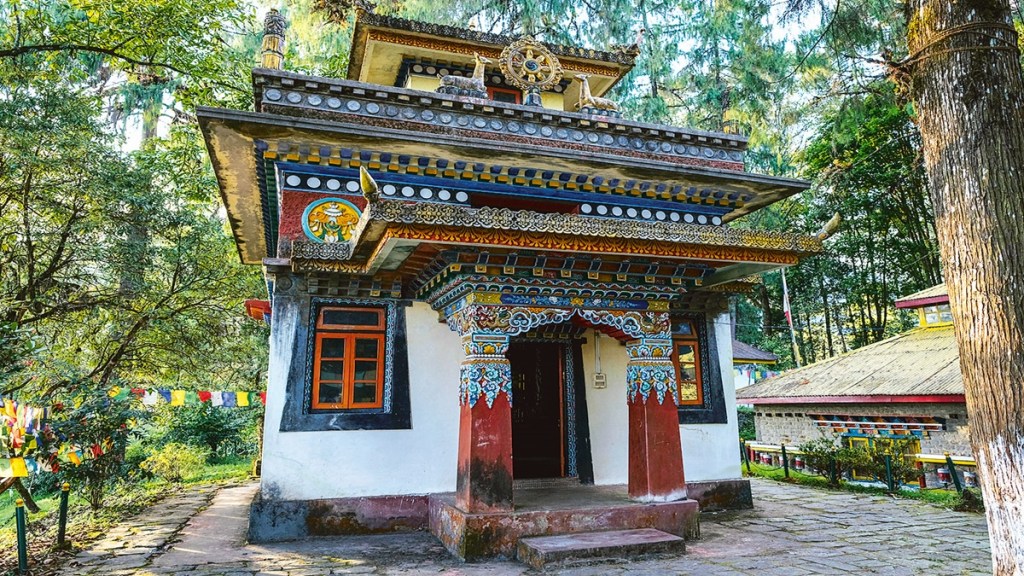It takes more than just a travel bug to reach Yuksom, a remote town located in the western part of Sikkim. In the absence of any direct flight to the region, the only way to access the area is by road from the nearest airport in Bagdogra near Siliguri in West Bengal. Therein lies the catch. The zig-zag hilly roads are marked by rough patches at many places and are virtually non-existent in some. The journey can be backbreaking, to say the least, and that may act as a deterrent to some people.
If you’re travelling from outside the region, ensure that you take a flight that lands at Bagdogra latest by noon so that you can start your journey by road soon thereafter. Beyond that, chances are that you will reach your destination well after dusk, which is not advisable considering the roads are narrow, isolated, and poorly lit. It was a long wait. I took a morning flight from Delhi to reach Bagdogra a little over two hours later and then a seven-and-a-half-hour-long bumpy ride onwards on a Toyota Innova to west Sikkim.
About 150 km, with a quick lunch break in between, and two halves of an Avomine tablet later, I came far enough to see why people undertake this odyssey in the first place. I was standing at the parking lot of Tashighang Retreat, my home for the next two nights. On one side was the imposing building of the hotel with an architectural style that blends seamlessly with the local art and culture. The rest offered a panoramic view of Mt Kanchenjunga aka Khangchendzonga, the third highest mountain in the world, in all its glory.
The air was moist from the day’s rainfall, reminiscent of the typical weather that characterises Yuksom towards the fag end of summer in May. This time of the year is, however, pleasant with temperatures revolving around 10 degrees Celsius. I could feel the freshness, and as a city person used to 200-plus AQI on most days of the year, the air actually felt too pure to breathe in.
Yuksom holds special religious and cultural significance, especially among the Bhutia community of Sikkim. Established in 1642 by Phuntsog Namgyal, who was the first Chogyal (temporal and religious king) of Sikkim, it was also the first capital of the erstwhile kingdom of Sikkim. It’s a small place — as per 2001 census, there are only 364 households in Yuksom inhabited by 1,951 persons. However, the visiting population of tourists far exceeds the permanent population as Yuksom falls at the head of the Khangchendzonga National Park and also serves as the base camp for trekking to Mt Khangchendzonga.
Yuksom contributes around 25% of the state’s total tourist footfall, Indra Hang Subba, the lone Lok Sabha MP from the state, tells me. “Despite the challenges posed by the Covid pandemic, Yuksom has witnessed a notable increase in tourist arrivals. The occupancy rate in hotels remains favourable, especially during the peak seasons of April, May, September, October, November and December. These months witness a substantial influx of visitors, highlighting the allure of Yuksom as a preferred travel destination,” he adds.
Otherwise calm and peaceful, the atmosphere during my visit was particularly charged owing to the state government’s decision to hold the maiden edition of Sikkim Arts & Literary Festival (SALF) in Yuksom. All sign boards installed at various places of the town pointed towards Norbugang, the coronation site of the first monarch of Sikkim and the main venue for the festival. SALF serves as a platform to showcase Yuksom’s rich historical and natural heritage, says MP Subba, who was in town to attend the festival. “As the first capital of Sikkim, Yuksom boasts a captivating history and offers visitors an opportunity to explore its remarkable cultural landmarks. The region’s abundant biodiversity, including over 500 bird species, more than 400 butterfly species and over 60 types of orchids, further add to its allure as a destination for nature enthusiasts. With its diverse offerings, the festival is poised to put Yuksom firmly on the tourist map, inviting visitors to discover its captivating blend of history, culture and natural wonders,” he adds.
Near the Norbugang throne is a stupa or chorten that was erected following the crowning of the first Chogyal by three Lamas (spiritual leaders) headed by Lhatsun Chempo. In fact, the name of the town comes from this significant moment of history — Yuksom literally means ‘the meeting place of the three learned monks’.
About a 15-minute walk downhill from Norbugang is the main market area that comprises just about 10-12 shops. One place that everyone told me to visit was Gupta Restaurant, a popular touch point for tourists arriving in Yuksom. This little eatery serves all kinds of local Sikkimese, north Indian, Chinese, and even Continental dishes — in their own inimitable style, of course.
Apart from a plate of juicy momos and a bowl of steaming-hot thukpa, I made peace with a Dansberg, one of the many beer offerings from veteran actor Danny Denzongpa-founded Yuksom Breweries’ stable. The obvious brew to try next was ‘chhang’, a local beer made by fermenting millet. Like the momos and the thukpa, chhang brought me closer to the people and its culture.
As I made my way out of the quaint little town through thick forests and occasional waterfalls, with wildflowers lining the roadside and the river Teesta and its tributary Rangeet running alongside, I could feel the mountains once again. The chill in the air was unmissable but it caught me unawares once in a while. Until I reached Bagdogra airport and Yuksom became a memory — a memory that has now become a treasure.

